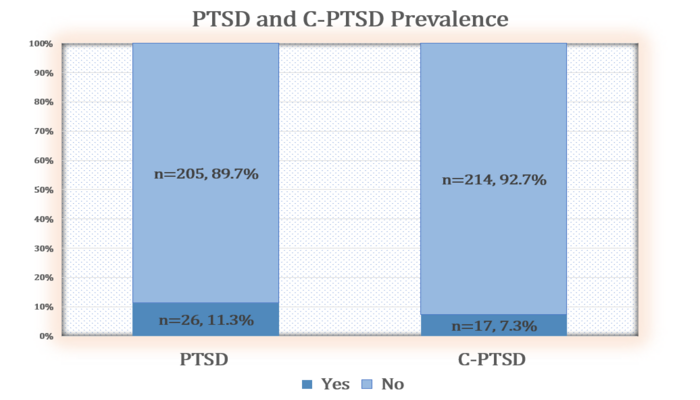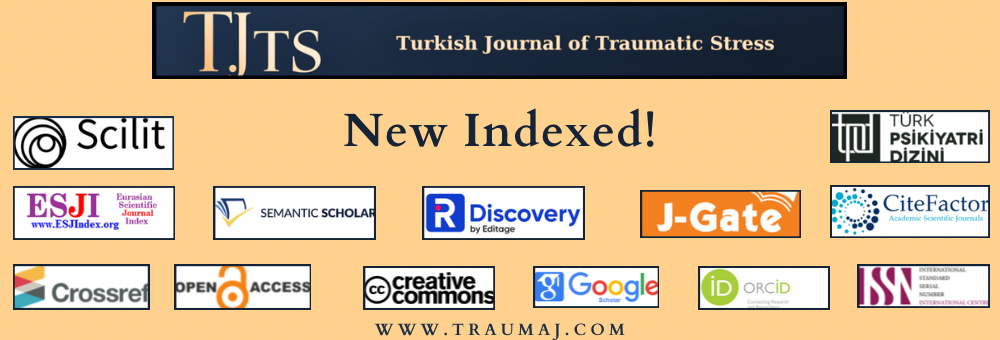Post-traumatic Stress Disorder (PTSD) and Complex PTSD (C-PTSD) According to ICD-11: A Study Conducted in Turkiye Following the Kahramanmaras Earthquake
PTSD and C-PTSD According to ICD-11: A study Conducted in Turkiye Following the Kahramanmaras Earthquake
DOI:
https://doi.org/10.63175/tjts.14Keywords:
Complex posttraumatic stress disorder, earthquake, International Trauma Questionnaire, posttraumatic stress disorderAbstract
ABSTRACT
Background: Post-traumatic stress disorder (PTSD) and Complex PTSD (C-PTSD) are significant mental health conditions that arise following exposure to traumatic events. While PTSD is often associated with single traumatic experiences, C-PTSD develops due to prolonged and repeated trauma, particularly in early life. Despite the increasing recognition of C-PTSD as a distinct diagnosis in the ICD-11, research on its prevalence remains limited, particularly in populations affected by natural disasters. This study aims to determine the prevalence of PTSD and C-PTSD among individuals affected by the 2023 Kahramanmaraş earthquake in Türkiye and examine potential age-related differences in symptomatology.
Methods: A cross-sectional study was conducted with 231 participants who directly experienced the earthquake. Participants completed the International Trauma Questionnaire (ITQ), which assesses PTSD and C-PTSD symptoms in accordance with ICD-11 criteria. Sociodemographic variables were also collected and analyzed. Statistical comparisons were performed between two age groups (18-31 years and 32-65 years) using chi-square and t-tests.
Results: The findings revealed that 11.3% of participants met the criteria for PTSD, while 7.3% were diagnosed with C-PTSD. No significant differences were observed between age groups in terms of PTSD and C-PTSD prevalence. However, younger participants (18-31 years) exhibited significantly higher scores for avoidance (p = 0.001) and disturbed relationships (p = 0.011).
Conclusion: This study contributes to the limited research on C-PTSD prevalence following natural disasters, highlighting the need for further investigations into age-related differences in trauma responses. The findings emphasize the importance of age-sensitive interventions and long-term mental health support for disaster-affected populations. Future research should adopt longitudinal designs and include diverse cultural and linguistic groups to enhance generalizability.
Keywords: Complex posttraumatic stress disorder, earthquake, International Trauma Questionnaire, posttraumatic stress disorder
References
1. American Psychiatric Association. Diagnostic and Statistical Manual of Mental Disorders, Fifth Edition. American Psychiatric Association; 2013.
2. Kessler RC, Sonnega A, Bromet E, Hughes M, Nelson CB. Posttraumatic stress disorder in the National Comorbidity Survey. Arch Gen Psychiatry. 1995;52(12):1048–1060.
3. Breslau N, Davis GC, Andreski P. Risk factors for PTSD-related traumatic events: a prospective analysis. Am J Psychiatry. 1995;152(4):529-535.
4. Abdallah CG, Averill LA, Akiki TJ, et al. The neurobiology and pharmacotherapy of posttraumatic stress disorder. Annu Rev Pharmacol Toxicol. 2019;59:171-189.
5. Çoban DA, Gündoğmuş İ. Travma sonrası stres bozukluğu belirti profilinin cinsel ve cinsel olmayan travma tiplerine göre karşılaştırılması. Anadolu Psikiyatri Derg. 2019;20(5):470-476.
6. Kul AT, Gündoğmuş İ. The effect of trauma type on the severity of post-traumatic stress disorder symptoms. Arch Clin Psychiatry. 2020;47(5):135-142.
7. Wang Y, Karstoft KI, Nievergelt CM, et al. Post-traumatic stress following military deployment: genetic associations and cross-disorder genetic correlations. J Affect Disord. 2019;252:350-357.
8. Karam EG, Friedman MJ, Hill ED, et al. Cumulative traumas and risk thresholds: 12-month PTSD in the World Mental Health (WMH) surveys. Depress Anxiety. 2014;31(2):130-142. doi:10.1002/da.22169
9. Cloitre M, Hyland P, Bisson JI, et al. ICD-11 posttraumatic stress disorder and complex posttraumatic stress disorder in the United States: a population-based study. J Trauma Stress. 2019;32(6):833-842.
10. Atwoli L, Stein DJ, Williams DR, et al. Trauma and posttraumatic stress disorder in South Africa: analysis from the South African Stress and Health Study. BMC Psychiatry. 2013;13:182.
11. Van Ameringen M, Mancini C, Patterson B, Boyle MH. Post-traumatic stress disorder in Canada. CNS Neurosci Ther. 2008;14(3):171-181.
12. Schein J, Houle C, Urganus A, et al. Prevalence of post-traumatic stress disorder in the United States: a systematic literature review. Curr Med Res Opin. 2021;37(12):2151-2161.
13. Forbes D, Fletcher S, Parslow R, et al. Trauma at the hands of another: longitudinal study of differences in the posttraumatic stress disorder symptom profile following interpersonal compared with noninterpersonal trauma. J Clin Psychiatry. 2012;73(3):372-376.
14. Herman JL. Complex PTSD: A syndrome in survivors of prolonged and repeated trauma. J Trauma Stress. 1992;5(3):377-391.
15. World Health Organization. The 11th revision of the International Classification of Diseases (ICD-11). Geneva: World Health Organization; 2018.
16. Rosenfield PJ, Stratyner A, Tufekcioglu S, et al. Complex PTSD in ICD-11: A case report on a new diagnosis. J Psychiatr Pract. 2018;24(5):364-370.
17. Cloitre M, Shevlin M, Brewin CR, et al. The International Trauma Questionnaire: development of a self-report measure of ICD-11 PTSD and complex PTSD. Acta Psychiatr Scand. 2018;138(6):536-546.
18. Vallières F, Ceannt R, Daccache F, et al. ICD-11 PTSD and complex PTSD amongst Syrian refugees in Lebanon: the factor structure and the clinical utility of the International Trauma Questionnaire. Acta Psychiatr Scand. 2018;138(6):547-557.
19. Møller L, Augsburger M, Elklit A, et al. Traumatic experiences, ICD-11 PTSD, ICD-11 complex PTSD, and the overlap with ICD-10 diagnoses. Acta Psychiatr Scand. 2020;141(5):421-431.
20. Liu A, Tan H, Zhou J, et al. An epidemiologic study of posttraumatic stress disorder in flood victims in Hunan, China. Can J Psychiatry. 2006;51:350-354.
21. Goenjian AK, Najarian LM, Pynoos RS, et al. Posttraumatic stress disorder in elderly and younger adults after the 1988 earthquake in Armenia. Am J Psychiatry. 1994;151(6):895-901.
22. Kongshøj ILL, Berntsen D. Is young age a risk factor for PTSD? Age differences in PTSD symptoms after Hurricane Florence. Traumatology. 2023;29(2):211-223.
23. Eşsizoğlu A, Yaşan A, Bülbül I, Onal S, Yildirim EA, Aker T. Bir Terörist Saldiri Sonrasinda Travma Sonrasi Stres Bozukluğu Gelişimini Etkileyen Risk Faktörleri [Factors affecting the diagnosis of post-traumatic stress disorder after a terrorist attack]. Turk Psikiyatri Derg. 2009;20(2):118-126.
24. Kurt E, Gülbahçe A. Van depremini yaşayan öğrencilerin travma sonrası stres bozukluğu düzeylerinin incelenmesi. Atatürk Üniv Sos Bilim Enstitüsü Derg. 2019;23(3):957-972.
25. Ari M, Kokaçya MH, Çöpoglu ÜS, et al. Suriye-Türkiye sınırındaki Reyhanlı'da bombalı saldırı sonrası stres tepkisi, anksiyete ve depresyon düzeyleri. Anadolu Psikiyatri Derg. 2016;17(3):203.
26. Sakarya D, Güneş C. Van Depremi sonrasında travma sonrası stres bozukluğu belirtilerinin psikolojik dayanıklılık ile ilişkisi. Kriz Derg. 2013;21(1):25-32.
27. Akdağ B, Bozduman Çelebi S, Kılıçaslan F. Kahramanmaraş depremi sonrasında çocuk/ergen psikiyatristlerinde travma sonrası stres bozukluğu, ikincil travmatik stres ve tükenmişliğin incelenmesi. Dicle Med J. 2024;51(4):565-572.
28. Gündoğmuş İ, Ünsal C, Alma L, et al. Psychometric properties of the Turkish version of the International Trauma Questionnaire. J Am Acad Psychiatry. 2023;32(12):1847-1865.
29. Lai TJ, Chang CM, Connor KM, et al. Full and partial PTSD among earthquake survivors in rural Taiwan. J Psychiatr Res. 2004;38(3):313-322.
30. Uğur M, Kartal F, Mete B, et al. Deprem sonrası akut stres bozukluğu olanlarda travma esnasındaki çözülmenin, anksiyete düzeyi, algılanan stres, anksiyete duyarlılığı ve deprem stresiyle baş etme ile ilişkisi. Türk Psikiyatri Derg. 2021;32(4):253-260.
31. Altindag A, Ozen S, Sir A. One-year follow-up study of posttraumatic stress disorder among earthquake survivors in Turkey. Compr Psychiatry. 2005;46(5):328-333.
32. Salcioglu E, Basoglu M, Livanou M. Long-term psychological outcome for non-treatment-seeking earthquake survivors in Turkey. J Nerv Ment Dis. 2003;191(3):154-160.
33. Li S, Guo C, Chan SS. ICD-11 posttraumatic stress disorder and complex PTSD among hospital medical workers in China: impacts of Wenchuan earthquake exposure, workplaces, and sociodemographic factors. Front Psych. 2022;12:735861.
34. Priebe S, Grappasonni I, Mari M, et al. Posttraumatic stress disorder six months after an earthquake: findings from a community sample in a rural region in Italy. Soc Psychiatry Psychiatr Epidemiol. 2009;44(5):393-397.
35. Hong C, Efferth T. Systematic review on post-traumatic stress disorder among survivors of the Wenchuan earthquake. Trauma Violence Abuse. 2016;17(5):542-561.
36. Hibino Y, Takaki J, Kambayashi Y, et al. Health impact of disaster-related stress on pregnant women living in the affected area of the Noto Peninsula earthquake in Japan. Psychiatry Clin Neurosci. 2009;63(1):107-115.
37. Pekovic V, Seff L, Rothman M. Planning for and responding to special needs of elders in natural disasters. Generations. 2007;31(4):37-41.
38. Xu J, Song X. Posttraumatic stress disorder among survivors of the Wenchuan earthquake 1 year after: prevalence and risk factors. Compr Psychiatry. 2011;52(4):431-437.
39. Kato H, Asukai N, Miyake Y, et al. Post-traumatic symptoms among younger and elderly evacuees in the early stages following the 1995 Hanshin-Awaji earthquake in Japan. Acta Psychiatr Scand. 1996;93(6):477-481.

Downloads
Published
How to Cite
Issue
Section
License
Copyright (c) 2025 Esra Yalım, Cansu Ünsal

This work is licensed under a Creative Commons Attribution 4.0 International License.







